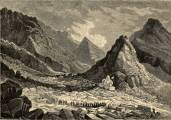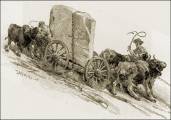


Lime City, Iowa, Lime Industry
By Megan Moeller
(Circa 1997)
"From 1875-1907 because of the need for processed lime for building purposes, Lime City flourished. It was located about 6 miles north/northwest of Wilton. It contained houses, stores, streets, a church, a school, telephone lines and a train track to haul the processed lime out. The only things left are the lime quarries growing up with trees and ruins of three kilns." (http://www.iowa-counties.com)
Lime City is a ghost town in Cedar County that holds special importance to me. My great, great grandfather, John Reese, came to Lime City, Iowa, in the late 19th century from Kellinghusen, Germany. He answered an ad in a local newspaper and soon him and several other families immigrated to America. Most of John's 6 children are buried near the remains of Lime City. Clara Reese, his second oldest, is my great-grandmother; she was born in Lime City.
Early Lime Use
Even before the emergence of Lime City, Cedar County farmers were burning lime for mortar for building materials on their land. The Wilton Herald from May 13, 1875 said that "there are seven farms engaged in the manufacture of lime" including those of Hinkhouse, Evans, Daut, Hain, and Kaufmann (Kaufmann 14, Frymoyer 1). The early demand for lime for building purposes in Davenport was also great, so oftentimes these private farmers would have their lime delivered to other areas besides their own. Expansion was possible because of the unique and plentiful limestone layers found in the bluffs of Sugar Creek. The special lime found here (dolomite) could easily be burned and the stone was chemically reduced to a fine white powder used in mortar. M.G. Mills owned a quarry on the banks of Sugar Creek and actively recruited young, unmarried men, especially immigrants, to come work at his lime kilns, known as the United States Lime Company or "lower kilns". All over the United States in this "Age of Enterprise", migrant peasants were eager to work in our rapidly increasing industrial society. Our textbook, America's History says that they "manned the machines, laid the railroad tracks, and performed the heavy construction labor that built the nation's cities. They were Europe's gift -- the most vigorous and hardworking people." H.J. Lowry also started his business about a mile farther up the creek called the Sugar Creek Lime Co. or "upper kilns". He also found migrant workers to be very useful in the processing of lime. As jobs increased so did the need for housing. A little "hamlet in the brush" was formed (Brown 1).
Boom of Lime City
Mr. Mills and Mr. Lowry were having trouble keeping up with the increased demand for lime. In 1883, the Rock Island Company laid railroad tracks to the U.S. Lime Co. at the request of Mr. Mills, who offered to pay the right of way for the tracks as long as the railroad built them. In a year, tracks were also built to the Sugar Creek Lime Co. All over the country, rails were making the business world smaller. Economic recovery after the Civil War led to this railroad exploitation of the Great Plains.
The kilns were very busy increasing their lime production and housing all of the railroad workers. For the workmen, company rooming and boarding houses were built and some workers at the lower kilns lived in railroad cars.
Around the kilns, a town was sprouting up. Lime City was the name appropriately given to this new town which was 9 miles south of Tipton and 5 miles north of Wilton. Streets were laid out around the boarding houses and family homes. A store was opened up by G. Wilkinson (see attached picture). Other new businesses included two meat markets, a saloon, a post office, where L.T. Munn was the postmaster, an ice house, two churches, and a two-room schoolhouse. The schoolhouse is still standing today and was attended by a couple of my ancestors, including Clara, my great-grandmother. Today it has been renovated into a house by John Hinkhouse and the old Lime City cemetery still stands on his property. The lime community was very close and had much pride in the city that they all helped form almost overnight.
Lime City had many business connections with Wilton in it's boom time. President M.G. Mills and many of his workers lived in Wilton, and the trains also had to back up all the way to Wilton in order to turn around. A telephone line was connected between here and Lime City with toll-free calls provided.
As people made their homes in this new town, an active social network developed. At the schoolhouse, spelling bees, singing classes, literary programs, and debates were held almost nightly. They drew families from all around the Sugar Creek area. Sledding and skating were also popular activities on Sugar Creek in the wintertime. Among the men, athletic contests like boxing and wrestling were popular. Ed Proctor, a legend of Lime City, was given the boxing name "Lime Kiln Ed" (Brown 1). When they weren't busy working at the kilns, they often traveled to nearby towns like Rochester for fights.
Mining the Lime
As business contacts grew, so did the demand for lime. As the demand for lime grew, so did the companies on the bluffs of Sugar Creek. They became larger, more efficient, and more expensive to maintain. Curtis Frymoyer's story in the Cedar County Historical Revue-1970 reports how in 1884 at the U.S. Lime Co., they began preparing to produce lime on an "immense" scale. A new kiln replaced the three little, old ones. It was 33 feet deep and capable of producing 120 barrels of lime a day. Eventually three of these "monster kilns" were erected. Along with the kilns, storage houses, cooling houses, and blacksmith shops were built on property.
North a mile at the Sugar Creek Lime Co., H.J. Lowry had a 6 kiln operation going. He also had storage houses and cooper shops as well as several tenant and boarding houses with kitchens. Employees here included Ed Proctor and John Reese, and they all worked for roughly $0.15 an hour (Brown 1).
Many steps were involved in producing the lime. According to Curtis Frymoyer's The Story of Lime City and other information about lime production, useable rock was first blasted out of quarries by dynamite. Manually, workers broke up the chunks by pounding them with sledge hammers. Steam powered cable cars would carry the pieces to the top of the kiln where they were dumped in for burning. Wood at the bottom of the monstrous kilns was lit and soon they were huge furnaces. Ed Proctor was one of the firemen at Lime City, and he put wood in through an opening at the bottom of the kiln and did what was called "shaking down the kilns" (Brown 1). Wood needed to be added frequently to keep the intense fire going. The searing hot lime was lured out of the bottom of the kilns and then placed in a cooling house. Finally the lime was packed tight into barrels and shipped out by the trains to various building sites.
The intense heat that was needed day and night to power the kilns required a lot of wood. Timber was stripped from the green Iowa land for miles around. Many area farmers cut and sold wood to the lime companies for extra income in the winter (Frymoyer 8). Cord wood was constantly being replanted and cut down again. Cedar County was abundant in timber. In 1850, it had 76,000 acres of timberland (Brown 11). The Andreas Atlas shows the county with only 22,700 acres in 1875. This wasn't even that long after the opening of the kilns. To keep up with the growing demand for energy, oil was experimented with. Oil was a new fuel alternative that was more expensive, but also more efficient (Frymoyer 14). Even with the new fuel alternatives, lime production began to decline in the early 20th century.
Decline
Aside from the depletion of the wood supply and the high costs of changing over to petroleum fueling, lime production slowed. Cement was a new product that many builders preferred over lime. When the railroad tracks needed repaired in 1900, the railroad company would not allow their trains to travel to Lime City. A poem by Proctor found in the Wilton Advocate reads:
"The Quarry they say when in her day was
As lively a place as they made them but the
Rock Island tore up her tracks, Uncle Sam put
A stop to the hacks and that left
The old place deserted."
Small scale production continued until around 1907 when the railroad tracks were removed. Competition from other industries and the unwillingness of the Rock Island Company and quarry owners to repair the tracks ultimately led to the demise of Lime City. Most families moved out of Lime City to Wilton or surrounding areas. Only the ruins of three kilns, four houses, some railroad ties, and many stories of this once thriving community remain. Even today, though, when using a zip code search on the US Postal Service's web page, Lime City still comes up under 52778, Wilton's zip code.
Legacy
The railroad quit in 1907. The post office was closed in 1908. Families moved out. Original workers have long since died, but the legacy of Lime City lives on. Not many places can claim to have the same unique rock formations capable of being a site for lime production. Many similarities are found in Maquoketa at the Hurtsville Lime Works. This lime producing site was deserted also, but in 1981 it was reopened as a tourist attraction. They have realized the historical and educational wealth that their kilns have.
Even though our kilns are hidden and brush covered, people with connections to Lime City still visit. The cemetery, which is visible from I-80, where many of the Proctors are buried, is still kept up. Articles and interviews have recounted the days of the short-lived Lime City so that it isn't forgotten. The Quad-City Times recently did an article on Cedar County ghost towns, and Lime City was a featured site. A web page commemorating Lime City has also been set up, and many ancestors of workers and history buffs appreciate that people are keeping the memory alive. Lime City is still our "little hamlet in the brush."
Works Cited
"Cedar County Ghost Towns", Quad-City Times 5 April 1998: M5.
Curtis Frymoyer, "The Story of Lime City", Cedar County Historical Revue (1970) 1-21.
Jeff Kaufmann, "Sugar Creek", Cedar County Historical Revue (1990) 13-14.
Internet. www.iowa-counties.com Key words: Lime City, ghost towns, Cedar County.
Marilyn Brown, "Our lime kilns could be hidden treasures", Wilton Advocate 4 July 1985. 1,11.
Marilyn Brown, "Ed Proctor- A legend from the days of Lime City", Wilton Advocate 11 July 1985. 1,11.
Michael P. Conzen. America's History, Vol.2 since 1865. (New York: Worth, 1997) 523,567.
Warren Petersen, Reece Family History (1997) 17.
Lime City, Iowa, Lime IndustryCommercial use of material within this site is strictly prohibited. It is not to be captured, reworked, and placed inside another web site ©. All rights reserved. Peggy B. and George (Pat) Perazzo.